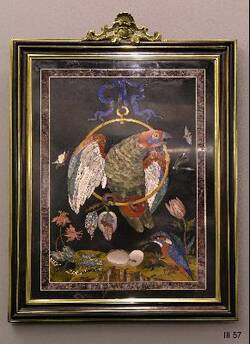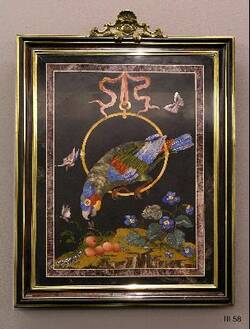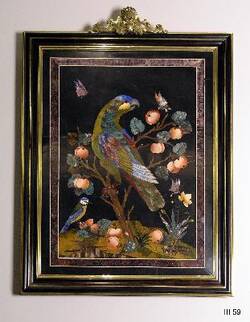The colourful parrots you see on this wall appear at first sight to be paintings. But they really consist of pieces of stone fitted closely together – a technique known as intarsia, or Florentine Mosaic. The pictures you see here were designed by Baccio Cappelli, a master of intarsia, and they were executed in the grandducal workshops of Florence. The six colourful panels – five of which show parrots; the sixth, in the next room, shows a greedy owl – are all in the same style.
Producing such intarsia panels, known as commessi, was technically complicated and very time-consuming. First came the design. Then a so-called scarpellini selected stones with the appropriate colour and structure. The gem-cutter sawed these hard stones, pietre dure, in slices only a few millimetres thick. With the aid of templates, the required shapes – for instance, that of a leaf, part of a feather or a butterfly’s wing – were sawn out of the slice. Usually the cut was angled out-and-upwards so the various pieces would fit together exactly. When all the sections of a motive had been cut, they were fitted on a flat surface like a jigsaw puzzle, and glued. Finally, the upper surface was polished. This entire process was of course overseen by the maestro of the workshop. And there’s no doubt that Baccio Cappeli was a maestro! He has signed the back of that picture of a parrot perched in a ring, which you see on the far left.
Further Media
- Location & Dating
- Florence, Galleria dei Lavori, around 1733
- Material & Technique
- Agate, quartz, amethyst, jasper, lapis lazuli, black polishable limestone, slate; wooden frame, bronze, gilt
- Dimenions
- H 60,5 cm, B 45,0 cm (ohne Rahmen); Gewicht: 12,2 kg
- Museum
- Grünes Gewölbe
- Inventory number
- III 67



